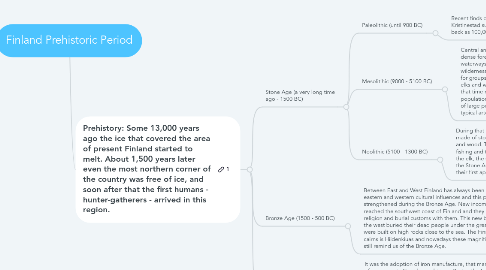
1. Prehistory: Some 13,000 years ago the ice that covered the area of present Finland started to melt. About 1,500 years later even the most northern corner of the country was free of ice, and soon after that the first humans - hunter-gatherers - arrived in this region.
1.1. Stone Age (a very long time ago - 1500 BC)
1.1.1. Paleolithic (until 900 BC)
1.1.1.1. Recent finds of worked flint tools in a cave at Kristinestad suggest sporadic human presence as far back as 100,000 years ago, between Ice Ages.
1.1.2. Mesolitihic (9000 - 5100 BC)
1.1.2.1. Central and south-eastern Finland was an area of dense forest with thousands of lakes. Labyrinthine waterways provided routes through the northern wilderness. The forests and lakes offered a way of life for groups of people. They hunted seals, Eurasian elks and waterfowl, they fished and they gathered. At that time new ideas reached the northern population, ceramics being one example. Fragments of large pots decorated with a comb-like tool are typical artefacts found in the settlements of this time
1.1.3. Neolithic (5100 - 1300 BC)
1.1.3.1. During that time tools, weapons and ornaments were made of stone or other organic materials like bone and wood. The population lived by hunting and fishing and the animals most important to them were the elk, the seal and the beaver. At the very end of the Stone Age agriculture and cattle breeding made their first appearance in Finland.
1.2. Bronze Age (1500 - 500 BC)
1.2.1. Between East and West Finland has always been a meeting place for eastern and western cultural influences and this position strengthened during the Bronze Age. New incomers from Scandinavia reached the southwest coast of Finland and they also brought a new religion and burial customs with them. This new bronze culture from the west buried their dead people under the great stone cairns, which were built on high rocks close to the sea. The Finnish name for these cairns is Hiidenkiuas and nowadays these magnificent cairn burials still remind us of the Bronze Age.
1.3. Iron Age (500 BC - 1150 AD)
1.3.1. It was the adoption of iron manufacture, that marked the beginning of a new era in Finnish pre- history. During the Iron Age, agriculture and cattle breeding became more important and the human settlement in southern Finland became more concentrated. Individual small farms evolved into clusters and many historically known Medieval villages had their origins in the Iron Age. The waterways were still important traffic routes at this time, but an old overland Ox Road (Härkätie) from Turku to Hämeenlinna probably also dates back to this period. This period was diveded into 4 era,
1.3.1.1. Pre Roman Period
1.3.1.2. Roman Period
1.3.1.3. Migration Period
1.3.1.4. Merovingian Period

